Table of Contents
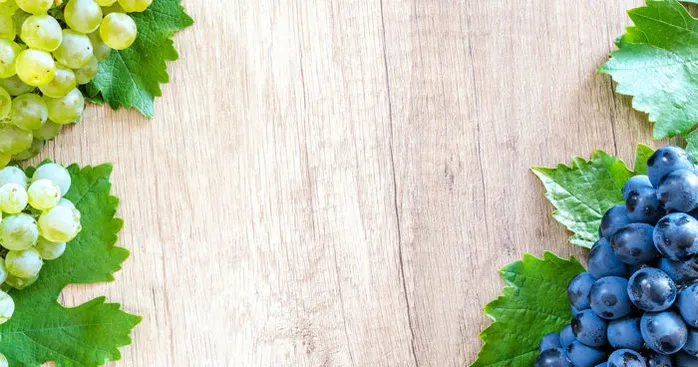
Korean and white grapes offer a world amazing flavor!
Beyond the classic blue grape, these varieties boast unique tangy and sweet profiles, making them a delightful addition to any dish.
But did you know that the cultivation of grapes dates back to a staggering 8000 years ago? (1)
That’s right, traces of ancient vineyards have been found across the Middle East, proving that grapes have been enjoyed for centuries.
In modern times, grapes have only continued to grow in popularity.
In fact, over 70 million tons of grapes were grown annually worldwide! (2)
But it’s not just their delicious taste that makes grapes so special.
These little fruits pack a powerful punch when it comes to nutrition, with studies linking the consumption of grapes to a reduced risk of cancer, heart disease, and high blood pressure.
So, next time you enjoy a handful of grapes, remember that they’re not just a tasty snack, but a nutritious one as well!
In this article, we are covering three main grape varieties: White grapes, Korean grapes, Blue grapes!
We start with presenting each variety, how does it taste? Where does it come from? What are the main uses?
The second part focuses on carbs in each of the three kinds of grapes mentioned above alongside some nutritional information.
The last part is covering the benefits of grapes in general and some tips about how to buy the best grapes, and how to keep grapes fresh.
Korean grapes:
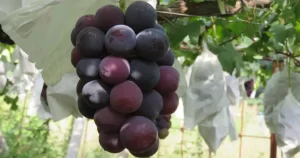
This is a very famous grape variety in East Asia and goes by different names.
In Japan and Korea, it is called “Kyoho”, the rest of the world likes to call them “Korean grapes” and “Japanese grapes” but either way they are all the same. (3)
This type is actually a hybrid of the two famous types: the American Vitis labrusca (fox grape) and the European Vitis vinifera (common grape).
In fact, it was first originated in Japan back in 1937 and since then it has gained a lot of popularity due to its distinguishing color and big size.
One single grape of the Korean “Kyoho” weighs about 20 grams and a whole cluster can weigh more than 400g (almost 1lbs). (4)
However, these grapes are known for their dark purple skin that is easily peeled to unveil a very dense and fine flesh full of juice.
These flesh properties are inherited from the “Common grape”.
In Korea, Kyoho grapes are eaten with or without peel depending on the person, and due to their expensive price, some people offer them as fancy gifts.
The Korean grapes are harvested during fall which is why throughout this season you can find them topping most of the sweet dessert recipes including cakes, parfaits, or jellies.
Korean grape carbs:
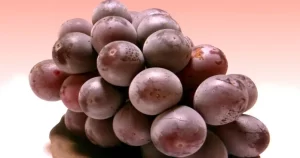
The Korean or “Kyoho” grapes are very rich in vitamin C which strengthens the immune system and helps reduce inflammation.
Just like most grapes, Korean grapes are a good source of potassium, a mineral capable of regulating fluid levels within the body.
These grapes are also a good source of resveratrol which is a phytonutrient that plays a key role in maintaining heart health.
This information counts for 100g (9 or 10 grapes) of the famous Korean grapes “Kyoho”: (5)
- Calories: 56
- Carbs: 15g
- Dietary Fiber: 2.9g
- Sugar: 12g
- Vitamin A: 2%
- Vitamin B6: 5.5%
- Vitamin C: 15%
- Potassium : 5%
- Calcium: 1%
- Iron: 2%
White grapes:
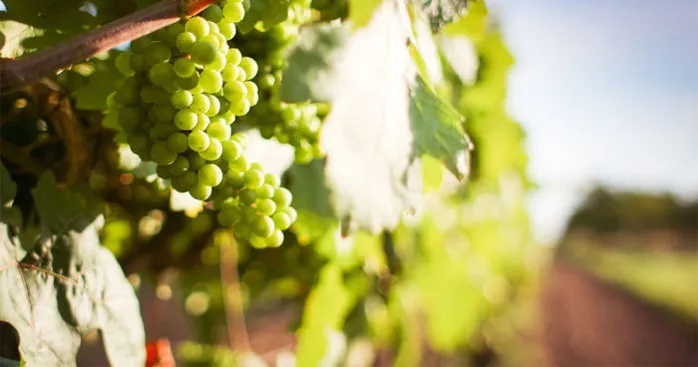
These grapes are close cousins to the famous red ones and they are the second variety to be cultivated, after red grapes.
White grapes are white because they don’t contain the coloring pigments “anthocyanin” in their skin.
However, these grapes are very neglected because of the clinical studies that only show the benefits of red grapes and red wine.
It’s for this reason that most of the studies focus on anthocyanin and its health virtues, this coloring pigment doesn’t exist in white grapes.
White grapes have many different versions because almost every country harvests their own white grapes and this explains the different tastes of white wines.
For instance, France is the world’s capital for white grape vineyards since it is known for many white grapes. (6)
The “Chenin Blanc” grape for example comes from France while Italy grows its own white grape called “Garganega”.
In the US, several types of white grapes are being harvested with the most common two beings, Chardonnay and Colombard.
A “blanc de blanc” champagne and Burgundy’s white wine are 100% made of Chardonnay.
Colombard is mostly used for blended white wine as it tastes more acidic but it can also be used to produce crispy white wines with a citrus aroma.
You notice that most of the talk is about white wine made from white grapes, it’s because the majority, if not all, of the white grapes grown in vineyards, are used to make champagne.
White grape carbs:

Grapes in general are very rich in carbohydrates.
White grapes are the second most cultivated type, second to the citrus grapes (red).
It comes in the form of light-colored (greenish or yellowish) bunches and is widely used for the winery as mentioned above.
Furthermore, the good thing about grapes is that they are high in potassium and low in sodium.
They combine fibers and fructose which give these grapes recognized laxative effectiveness.
This information counts for a 100g (20 grapes) of white grapes: (7)
- Calories: 70
- Carbs: 16.1g
- Dietary fibers: 0.9g
- Sugar: 12.2g
- Vitamin B1: 4%
- Vitamin B6: 7%
- Vitamin B9: 8%
- Vitamin C: 5%
- Vitamin E: 6%
- Potassium: 11%
- Calcium: 1%
- Copper: 12%
- Selenium: 8%
Blue grapes:

As part of the grape family “Vitis Labrusca”, blue grape first originated in Massachusetts in a town called Concord which is why some people call it “Concord grape”. (8)
This type of grape is a little bit more acidic compared to other types but it has a juicy sweet taste which makes it refreshing to eat.
These grapes are covered with a fine stiff skin that breaks in once you bite into it, and that makes the flesh pop into your mouth suddenly.
The blue grapes are perfect to pair with dark chocolate or a glass of red wine. It also makes a perfect fruit refresher for pies or combined with rosemary to use as a filling for bread.
Nonetheless, One thing you immediately notice when you see blue grapes is the thin white film covering each grape.
That film is made of a natural wax that is not harmful to us humans but it offers great protection to the plant against bacteria, heat, and humidity. (9)
However, if you are still worried about that, just a gentle rubbing or washing them with water will take that wax off.
Blue grapes are also often used to make juice or jellies because they can easily be pilled compared to red or green grapes.
Blue grape carbs :

The color of these grapes is caused by the existence of anthocyanins which are micronutrients such as myricetin, quercetin, kaempferol.
These micronutrients have antioxidant properties that give the body several health benefits.
Alongside the coloring micronutrients, blue grapes contain other antioxidants such as lutein, zeaxanthin, and beta-carotene.
This information counts for 100g (20 grapes) of blue grapes: (10)
- Calories: 57
- Carbs: 16.2 g
- Dietary fibers: 2.4g
- Sugar: 9.96g
- Vitamin A: 3%
- Vitamin B6: 5%
- Vitamin B9: 13%
- Vitamin C: 10%
- Vitamin E: 2%
- Potassium: 9%
- Copper: 7%
- Iron: 2%
- Selenium: 4%
Grapes health benefits:
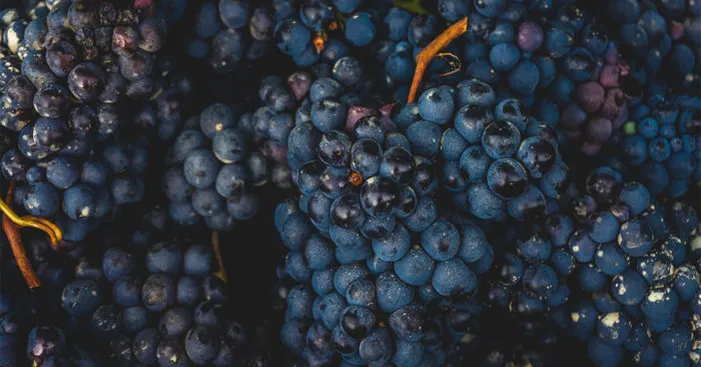
- Prevent blood clotting:
- Recently French scientists have discovered that grapes are better than aspirin when it comes to preventing thrombosis (a condition in which blood clots form inside blood vessels). (11)
- Grapes also lower the bad cholesterol levels in the blood and this can promote better cardiovascular health.
- Increase blood sugar levels:
- This fruit is full of sugar in the form of glucose which is easily absorbed by the body. (12)
- Although this is not healthy for people who deal with hyperglycemia (blood sugar level high most of the time), it is very beneficial for people who suffer from hypoglycemia.
- When the body has a low level of blood sugar, drinking grape juice or snacking on a couple of grapes will quickly relieve the symptoms.
- May prevent cancer:
- Grapes contain a good amount of anti-cancer elements that can prevent healthy cells from developing cancer.
- These natural substances found in grapes may have the ability to slow the spread of an already existent cancer. (13)
- Fight aging:
- Due to its richness in flavonoids (a plant chemical with antioxidant properties), grapes offer good resistance against aging as it eliminates free radicals in the body.
- Stimulate brain function:
- Grapes contain polyphenols and these are micronutrients filled with many health benefits. (14)
- These nutrients are proven to stimulate brain function and increase cognitive abilities.
- They also have antioxidant properties which makes them very beneficial for the neurotransmission process as they fight free radicals in the nerve system.
How to buy the best grapes?
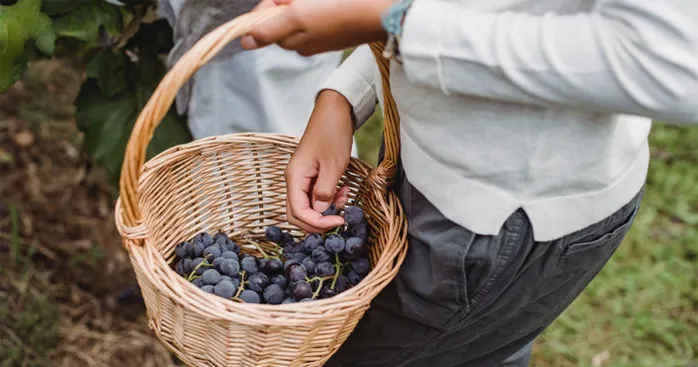
Generally speaking, when selecting grapes, the bruises and the size of the fruit doesn’t have a consequence on the taste.
The main idea here is to look at the quality of the flesh inside.
Grapes that have hard flesh are often under-ripen, and you’ll notice that they have bitterness and poor taste.
On the other hand, grapes that are too soft are most likely spoiled.
Try to look for grapes that have a firm texture, are not too hard, not too soft, and taste juicy. (15)
However, to do that try to taste the grapes before you buy them.
It’s best to taste more than two grapes to really have an accurate tasting since the bitterness is only felt when you eat more than two grapes.
Conserving grapes:
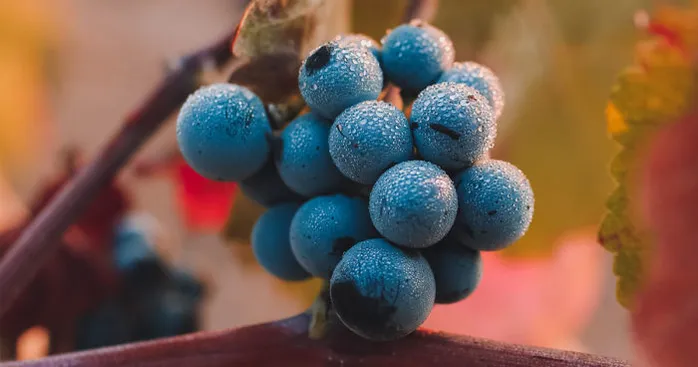
Grapes can be kept at room temperature for a week or refrigerated for up to 12 days.
However, you should always keep the grapes away from onions or leeks because they can absorb the smell of these two vegetables and the taste of grapes won’t be the same. (16)
Grapes can be frozen peeled or unpeeled depending on what you want to use them for.
Whether they are blue, red, green, or purple, grapes are a perfect, delicious snack that has a lot of virtues.
References:
(1): History of Amphorae Worldwide | Wine History Project of San Luis Obispo County
(2): World Grape Production by Country – AtlasBig.com
(3): https://minnetonkaorchards.com/kyoho-grapes/
(4): sakura.co/blog/japanese-kyoho-grapes/
(5): Generic – Kyoho Grapes calories, carbs & nutrition facts | MyFitnessPal
(6): Main white varieties in France – Gourmet Hunters Blog
(7): Grapes Nutrition: Amazing Nutritional Facts About Grapes And Health Benefits – NDTV Food
(8): Blue Grape (fgcu.edu)
(9): What’s the white stuff on grapes? – Eat Or Toss
(10): Carbs in Concord Grapes | Carb Manager
(11): Grapes and Cardiovascular Disease – PMC (nih.gov)
(12): dextrose (hhu.de)
(13): Grapes May Stop Cancer Cells (webmd.com)
(14): The Power of Grapes in Brain Health – KINETIQ LIFE
(15): Picking Grapes in Stores: How to Choose the Best Grapes – Sun World (sun-world.com.au)
(16): How to Store Grapes – Sun World (sun-world.com.au)
